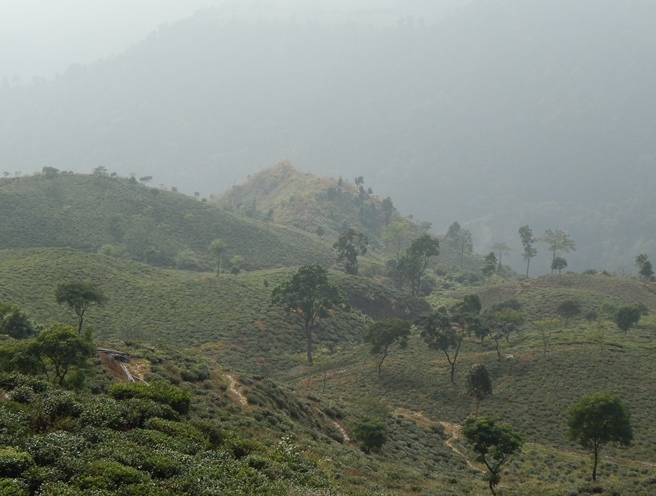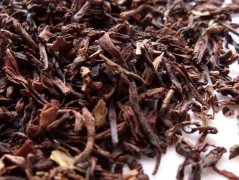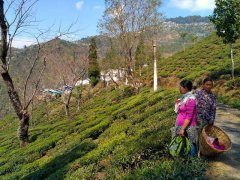Where can I buy authentic Darjeeling black tea? Which manor tastes good Darjeeling black tea?
Darjeeling autumn picking tea, often referred to as Darjeeling autumn picking tea, Darjeeling autumn picking, or the less common third picking black tea, is Darjeeling tea harvested after the autumn rainy season. It is usually described as having a strong taste, especially compared to the more delicate spring-picked tea and summer-picked tea, the color of its tea tends to be darker, although it is lighter and more tender than the monsoon tea / rain-picked tea between the second picked summer tea and the third picked autumn tea. These teas are usually harvested in October and November.
The dry tea leaves picked in autumn are generally loose black tea with a slightly greenish appearance.
Pick Darjeeling black tea in autumn
Autumn Hanqing tea tends to be larger than the previous two seasons, although the difference may be slight compared to other teas, as most Darjeeling Tea is still made from small-leaf tea varieties.
Compared with the same grade of tea from similar gardens, Darjeeling Tea brewed in autumn is often cheaper than the first or second tea season, but more expensive than monsoon tea or rain tea or different brewing tea mixtures. However, it is difficult to summarize the price or quality; the price of high-grade autumn picked tea from some estates is often higher than that of spring or summer picked tea from others.

Take the autumn-picked black tea of Jungpana Manor under the brand Udyan Tea in 2016 as an example:
This kind of tea is slightly different from other Darjeeling Tea. The leaves are so large that they look more like Wuyi oolong tea than from Darjeeling. This Darjeeling autumn picking tea has a strong aroma, with aromas of caramel and malt, with typical fruit / floral / botanical aromas, with a typical ruddy flavor of Darjeeling autumn.
When pouring hot water, an interesting pungent smell that is completely unnoticed emanates from the dried leaves, and the fruity aroma is mixed with a hint of not very pleasant aroma.
This kind of tea tastes and smells very different. There is a surprising lilac aroma, which is rarely encountered in black tea, only in some herbs (such as basil). The brewed tea also has this very slight, mild sharpness or sharpness, just enough to keep it interesting. It doesn't smell as smooth as dried leaves.
The stronger the tea, the better it tastes, but you need to be careful not to brew it too deep. Soak a little more than a teaspoon of tea for five minutes, but not for too long. The only problem is that if the first brew takes a long time, the taste of the rebrewed tea will not remain much, but it can still be re-brewed. If you want a very smooth, mellow tea, it will be effective to brew it for 2-3 minutes for the first time.
This kind of tea is pleasant and interesting, but its less prominent other teas come from Udian tea, such as Castleton manor black tea or Himalayan oolong tea.
Important Notice :
前街咖啡 FrontStreet Coffee has moved to new addredd:
FrontStreet Coffee Address: 315,Donghua East Road,GuangZhou
Tel:020 38364473
- Prev

What's the taste of Darjeeling summer picking black tea? Is the price of authentic Darjeeling black tea expensive? how much is it per jin?
Darjeeling summer tea picking refers to Darjeeling Tea harvesting at a specific time, in the summer after spring tea picking. This kind of tea is also known as Darjeeling summer tea or Darjeeling summer picking. The harvest time of the second green is higher than that of the first, but much earlier than the peak of the monsoon season. Tea harvested during the monsoon season is called monsoon tea or rain tea, unlike summer tea, which is usually considered to be of poor quality
- Next

What are the most famous high-end brands of Darjeeling black tea? How do you drink Royal Darjeeling black tea?
Winter Darjeeling is Darjeeling Tea's tea that harvests earlier than the first tea in a year. Picking Darjeeling in winter is not common and only a few estates are produced, such as Arya Arya Manor. Dongji Darjeeling is regarded by many tea lovers as black tea that has attracted a lot of attention and everyone wants it. In addition, not only because the quality of winter picking Darjeeling is very unique, but also because of it
Related
- A complete list of coffee bean names and their meanings! What is Yejia Shefi coffee? Where is Mantelin coffee?
- What grade does Arida Manor Kaduai coffee beans belong to? What treatment is Arida ASD slow anaerobic sun exposure?
- The milk tea cup becomes smaller?! Overlord Tea Girl launches a new "Return to Yunnan" series
- Accused of selling counterfeit and high-priced coffee beans! Well-known boutique coffee brand "Oukelao" bowed and apologized!
- How to make espresso dumplings? Can I eat coffee and glutinous rice balls together?
- Save the unformed and stagnant powder cakes in one second! What is the problem with stagnant water in the powder bowl of the espresso machine?
- What does hand-brewed coffee stop mean? Why is it not recommended to make coffee by hand?
- Is it normal to smell like coffee? Why does coffee smell like alcohol? What's wrong with the strong smell of cold extract ice dripping ice brewed coffee?
- How to solve the problem that hand-brewed coffee extraction takes too long? Why is the water flowing so slowly when making coffee?
- The main points of making Australian white coffee, the proportion details, how does Australian white properly foam and blend the flowers?

